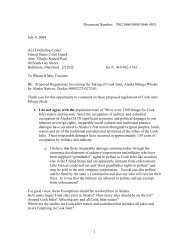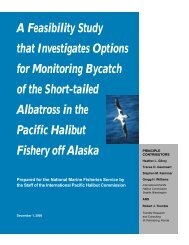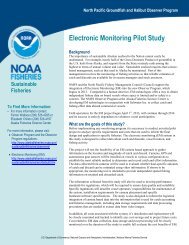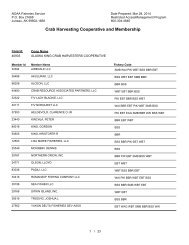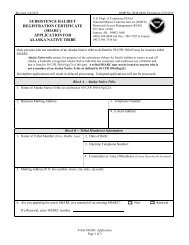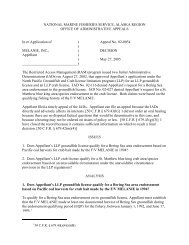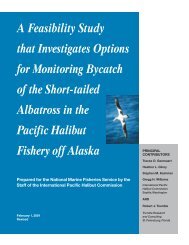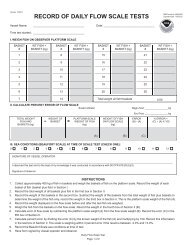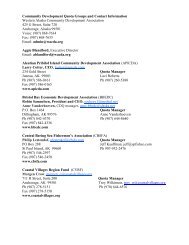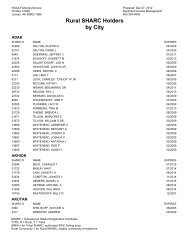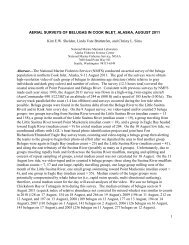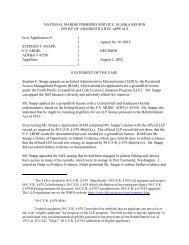Petition to List Lynn Canal Pacific Herring under the Endangered ...
Petition to List Lynn Canal Pacific Herring under the Endangered ...
Petition to List Lynn Canal Pacific Herring under the Endangered ...
Create successful ePaper yourself
Turn your PDF publications into a flip-book with our unique Google optimized e-Paper software.
A single DPS that includes <strong>the</strong> populations in <strong>the</strong> area from Baja California <strong>to</strong><br />
Sou<strong>the</strong>ast Alaska, with <strong>the</strong> nor<strong>the</strong>rn boundary being <strong>the</strong> border of <strong>the</strong><br />
zoogeographic zone near Dixon Entrance, or a line between Helm Bay and <strong>Lynn</strong><br />
<strong>Canal</strong>, Alaska. At this scale, <strong>the</strong> DPS is defined by <strong>the</strong> genetics investigations of<br />
Grant and Utter (1984), and by <strong>the</strong> zoogeographic boundary of Ekman (1953),<br />
Hedgpeth (1957), and Briggs (1974). This DPS exceeds any management area<br />
defined by DFO for Canadian populations.<br />
(S<strong>to</strong>ut et al. 2001). The 2001 <strong>Pacific</strong> <strong>Herring</strong> Biological Review Team (BRT) rejected<br />
this DPS configuration, and determined that <strong>the</strong> Strait of Georgia DPS is one of several<br />
<strong>Pacific</strong> <strong>Herring</strong> DPSs along <strong>the</strong> west coast of <strong>the</strong> United States and Canada (S<strong>to</strong>ut et al.<br />
2001).<br />
In <strong>the</strong> 2005 Status Review, NMFS again proposed several expansive <strong>Pacific</strong> <strong>Herring</strong> DPS<br />
configurations <strong>to</strong> <strong>the</strong> BRT: reaching from San Diego, California <strong>to</strong> Sitka, Alaska. Again,<br />
<strong>the</strong> BRT refused <strong>to</strong> group <strong>Pacific</strong> <strong>Herring</strong> in sou<strong>the</strong>ast Alaska with populations <strong>to</strong> <strong>the</strong><br />
south. Therefore, at <strong>the</strong> very least, NMFS has implicitly determined that at least one DPS<br />
exists in sou<strong>the</strong>astern Alaska. The DPS analysis in this petition builds upon <strong>the</strong>se two<br />
BRT conclusions <strong>to</strong> identify <strong>the</strong> <strong>Lynn</strong> <strong>Canal</strong> <strong>Herring</strong> DPS.<br />
B. Application of <strong>the</strong> DPS Policy <strong>to</strong> <strong>Lynn</strong> <strong>Canal</strong> <strong>Herring</strong><br />
The following analysis of <strong>Lynn</strong> <strong>Canal</strong> <strong>Herring</strong> demonstrates that <strong>the</strong>y qualify as a<br />
distinct population segment <strong>under</strong> <strong>the</strong> ESA. As shown above, NMFS prior conclusions<br />
on <strong>the</strong> Georgia Basin DPS of <strong>Pacific</strong> <strong>Herring</strong> supports a delineation of <strong>the</strong> <strong>Lynn</strong> <strong>Canal</strong><br />
<strong>Herring</strong> DPS.<br />
In an analysis of herring population structure in coastal British Columbia,<br />
Beacham et al. (2001, 2002) demonstrated that localized populations were <strong>the</strong> exception,<br />
with <strong>the</strong> vast majority of herring populations sharing high amounts of genetic<br />
information. However, in two instances Beacham et al. (2001, 2002) found significant<br />
level of genetic differentiation using microsatellite loci: 1) spawning time; and 2) isolated<br />
location.<br />
In <strong>the</strong> case of Vancouver Island <strong>Pacific</strong> <strong>Herring</strong> populations, all observed genetic<br />
variability was due <strong>to</strong> <strong>the</strong> population being isolated by a constricted passage between<br />
islands and fiords. <strong>Lynn</strong> <strong>Canal</strong> <strong>Herring</strong> are similarly isolated from o<strong>the</strong>r SE Alaska<br />
herring <strong>to</strong> <strong>the</strong> south and west. In addition, <strong>Lynn</strong> <strong>Canal</strong> <strong>Herring</strong> are backed up in<strong>to</strong> inlets<br />
and bays, ra<strong>the</strong>r than inhabiting a continuous stretch along a major Strait or Passage.<br />
Therefore <strong>the</strong> <strong>Lynn</strong> <strong>Canal</strong> <strong>Herring</strong> may have developed unique adaptations over<br />
generations <strong>to</strong> exist in this relatively isolated location.<br />
The following sections analyses <strong>the</strong> <strong>Lynn</strong> <strong>Canal</strong> <strong>Herring</strong> population in <strong>the</strong> context<br />
of <strong>the</strong> DPS Policy. First <strong>the</strong> discreteness of <strong>the</strong> population is analyzed and <strong>the</strong>n <strong>the</strong><br />
significance of <strong>the</strong> population <strong>to</strong> <strong>the</strong> taxon is discussed.<br />
21



